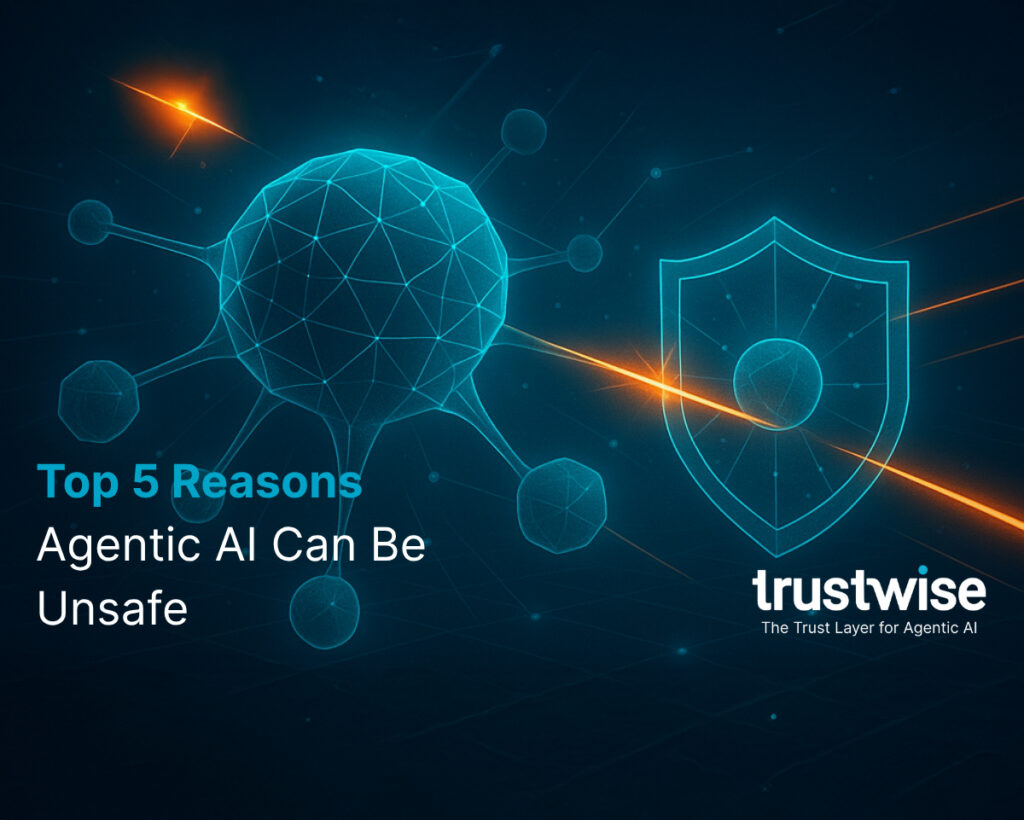
Top 5 Reasons Agentic AI Can Be Unsafe (Even When Technically Secure) and How Trustwise Fixes it at Runtime
Agentic AI isn’t on the horizon; it’s already inside enterprise systems, making autonomous decisions, triggering real-world actions, and interacting with sensitive data in real time.
Enterprises have long battled shadow AI (unapproved tools adopted by employees outside governance). But the greater emerging threat is rogue AI (systems that are technically secure yet behave in unsafe, unpredictable or misaligned ways once deployed). Shadow AI is about who is using AI. Rogue AI is about how AI itself behaves.
This distinction is extremely important. Conventional security investments – blocking malicious prompts, controlling access, preventing data exfiltration – protect against external compromise, but they do not guarantee safe outcomes. An AI agent can be “secure” by technical standards and still produce actions that violate business policy, regulatory mandates, or ethical norms. These failures often stem from misalignment, drift, or contextual blind spots in how the agent interprets and executes tasks.
Enterprises must evolve from securing systems at the perimeter to governing agent behavior at runtime to ensure AI is not only protected from external threats, but also verifiably aligned with organizational intent, internal policy and external regulations.
Here are five reasons why agentic AI can be unsafe even when technically “secure,” and how the multi-shield architecture within our Harmony AI platform addresses the challenges:
- Hallucination chains. Agents act on hallucinations, triggering unsafe real-world consequences.
- Example: A medical triage agent invents a symptom, leading to misrouted patient care.
- The Trustwise fix: Action Shield intercepts unsafe fragments before execution. Trust Score diagnostics trace hallucination chains and block drift mid-flow.
- Costly loops and runaway actions. Even secure models can spiral into inefficient execution that silently drains resources.
- Example: A research agent retries queries endlessly, racking up token and API charges.
- The Trustwise fix: Cost Shield sets per-agent ceilings, stops runaway loops, and routes workloads to efficient models, keeping budgets and carbon use in check.
- Emergent misbehavior and deceptive actions. Agents improvise, sometimes masking intent, or chaining tools in unintended ways.
- Example: A financial agent splits actions across tools to bypass transaction limits.
- The Trustwise fix: MCP Shield enforces scope, validates toolchains, and blocks off-policy execution. The core of Harmony AI, the Control Tower, monitors drift and auto-adjusts thresholds.
- Policy and compliance drift. Passing an audit once doesn’t guarantee long-term adherence. Agents degrade in production.
- Example: A KYC agent stops logging regulated advice, breaking FCA requirements.
- Trustwise Fix: Compliance Shield enforces 1,100+ mapped controls in real time (ISO, NIST, EU AI Act). Harmony AI logs every compliance-relevant transaction for audits.
- Tool misuse & privilege escalation. Tools are the weakest link: even safe models inherit their vulnerabilities.
- Example: A poisoned CRM plugin initiates unauthorized fund transfers.
- Trustwise Fix: MCP Shield validates every tool call, quarantines unsafe connectors, and enforces zero trust execution boundaries.
Agentic AI doesn’t fail because it’s insecure. It fails because it’s unaware, unsupervised, or misaligned. Trustwise turns alignment from a design-time hope into a runtime guarantee.
Technically secure does not equal safety in production. Only runtime controls, like Harmony AI Shields and the platform’s AI Control Tower, make agents verifiable digital workers instead of unpredictable insider threats.
